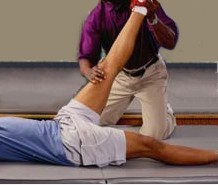Tight Hamstrings
Tight hamstrings can lead to injury and having a hamstring injury can be frustrating because pain is often persistent, healing can be slow, and the incidence of reinjury is high. Addressing hamstring tightness is one of the most important way to prevent injury.
Contents
How do you know if you have tight hamstrings?
How do you assess hamstring tightness
What can I do for tightness of the hamstrings
Should I use Static Stretches or Dynamic Stretches for my Hamstrings?
What are the risks associated with tightness in the hamstrings
Many studies on flexibility tend to focus on hamstrings because they are often tight, it is relatively easy to stretch them, and easy to measure range of motion. Studies generally show that even a single stretch is beneficial for improving flexibility although results only last a few minutes. Exercises must be done over the long term to achieve long term results. You can liken stretching the hamstrings to stretching a rubber band. The rubber band will eventually bounce back to its original length unless stretched again. In that way there is a carry over from one stretch to the next.
A study by J.Yimen et al found that after a four week stretching program at home, straight leg raise angle increased by 25%. (1) Participants in his study were men in their 20's who stretched their hamstrings in standing for 30 seconds, 6 repetitions, once a day.

How do you know if you have tight hamstrings
You often don't realize you have tight hamstrings until they start affecting movement or creating back or knee pain. In order to walk normally we can get away with having limited range in our hamstrings, but if we were to do anything more demanding such as running, bending, or partaking in sports. In order to determine if you have tight hamstrings you must measure their flexibility. This can be done by using one of the following tests:
- 90/90 degree straight leg raise
- Tripod sign
- Hamstring contracture test
- Straight leg raise
- Chair sit and reach test
How do you assess tight hamstrings
90/90 degree straight leg raise
While lying on your back, bend your hip to 90 degrees. When in that position extend your knee, bringing your foot up toward the ceiling. You can consider your hamstrings tight if the angle between your leg and the vertical is greater than 20 degrees.
Tripod sign
Sit on a chair such that your hips and knees are at 90 degrees. Straighten your knee or have someone straighten it for you. If you are unable to do this without your pelvis tilting, chances are you have tight hamstrings.
Hamstring contracture test
Sit on the floor with one knee bent up, foot on the floor, and the other leg straight out in front of you. Hold onto the knee that is bent and reach down toward the foot of your straight leg. If you can't touch your toes while keeping your knee straight, chances are you have tight hamstrings.
Straight leg raise
Lie on your back and lift your leg straight up while keeping your knee straight, or have someone lift it for you. An adult should be able to achieve 70-80 degrees if elevation. Children can often achieve 90 degrees.
Chair sit and reach test
To perform this test you should be sitting forward on the edge of a chair. One leg should remain bent with the foot flat on the floor; the other straight out extended in front, While keeping the back straight and head in normal alignment, reach down the extended leg with both hands and try to touch the toes of the extended leg. A study looking at 22 year old female university students showed a mean reach of 8 cm from their toes (SD of 9). (2)
What can I do for tight hamstrings
- A stretching program for tight hamstrings can be found here.
- You may benefit from a postural assessment by a physical therapist.
- A medical doctor will rule out any serious causes of tight hamstrings such as spondylolithesis, or tumours.
Static Stretches or Dynamic Stretches for Tight Hamstrings
Both dynamic and static stretching will increase hamstring flexibility. The goals of your stretching will determine which method of stretching is right for you.
If you are looking to increase the length of your hamstrings for a yoga program, dancing, running hurdles, etc. Static stretching of your hamstrings on a daily basis when not practicing has been shown most effective.
A study published in the Journal of Orthopaedic and Sports Physical Therapy compared static stretching and dynamic stretching of the hamstrings among 58 21 to 41 year olds.(3) Results showed that
- Both types of stretching improved hamstring flexibility.
- A 30 second static stretch was more effective than 30 seconds of dynamic stretching in improving hamstring flexibility.
- A 30 second static stretch over 6 weeks resulted in more than twice the gain in range of motion when compared to dynamic stretching.
When warming up prior to your activity, dynamic stretching is most appropriate as part of a complete warm up.
What are the risks associated with tight hamstrings
- hamstring strain
- mechanical back
- pain
- poor posture
- bursitis
1. Jari Ylinen, MD, PhD, Tuomas Kankainen, PT, Hannu Kautiainen, BA,
Asghar Rezasoltani, PhD, Tiina Kuukkanen, PhD and Arja Häkkinen, PhD Effect of stretching on hamstring muscle compliance. J Rehabil Med 2009; 41: 80–84
2. G Baltaci, N Un, V Tunay, A Besler, S Gerçeker Comparison of three different sit and reach tests for measurement of hamstring flexibility in female university students. Br J Sports Med 2003 37: 59-61
3. Bandy WD, Irion JM, Briggler M. The effect of static stretch and dynamic range of motion training on the flexibility of the hamstring muscles. J Orthop Sports Phys Ther. 1998;27:295–300